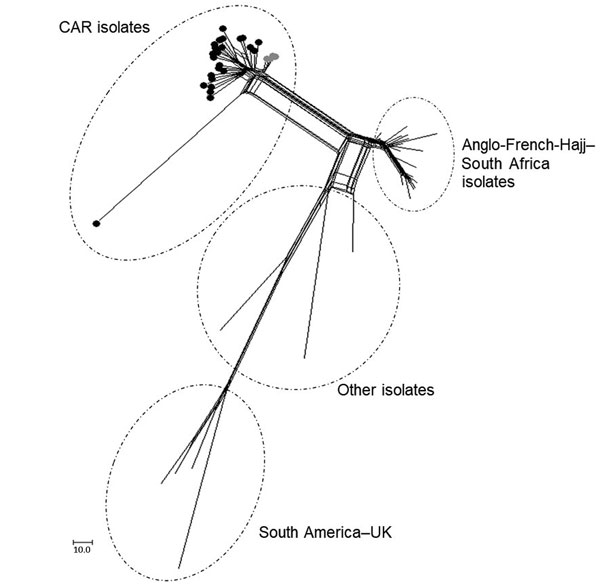Volume 24, Number 11—November 2018
Dispatch
Emergence of Neisseria meningitidis Serogroup W, Central African Republic, 2015–2016
Figure 2

Figure 2. Core genome multilocus sequence typing (MLST) neighbor-net phylogenetic network for the temporal distribution of Neisseria meningitidis serogroup W clonal complex sequence type cc11 isolates from CAR (n = 28) and reference isolates. The tree was built with neighbor-net SplitsTree graphs generated by SplitsTree4 version 4.13.1 (http://www.splitstree.org). The lineages Anglo-French-Hajj and South American/UK are indicated; other indicates 13 isolates retrieved from or based on the work of Lucidarme et al. (5). The isolates from CAR are also indicated by gray circles for the isolates of 2015 (n = 4 corresponding to on the PubMLST Neisseria database [http://pubmlst.org/Neisseria], 41187–41191) and by black circles for the isolates of 2016 (n = 24 corresponding to the PubMLST database, 44004–44027). The 30 isolates from the PubMLST database are as follows: 2290 (Saudi Arabia 2000); 19957 (United Kingdom 2000); 27087 (Burkina Faso 2002); 21588, 29326, 29337, 29370, 29371, 29382, 29384, 29401, 29406, 29422 (South Africa 2004–2005); 29775, 29928, 29929 (United Kingdom 2000); 30065, 30066, 30067 (Turkey 2005–2006); 30074 (Algeria 1999); 30075, 30079, 30107 (Senegal 2000–2001); and 31164, 31165, 42409, 42758, 42767, 42769, 50815 (France 2000–2016). CAR, Central African Republic.
References
- Békondi C, Bernede C, Passone N, Minssart P, Kamalo C, Mbolidi D, et al. Primary and opportunistic pathogens associated with meningitis in adults in Bangui, Central African Republic, in relation to human immunodeficiency virus serostatus. Int J Infect Dis. 2006;10:387–95. DOIPubMedGoogle Scholar
- Bercion R, Bobossi-Serengbe G, Gody JC, Beyam EN, Manirakiza A, Le Faou A. Acute bacterial meningitis at the ‘Complexe Pédiatrique’ of Bangui, Central African Republic. J Trop Pediatr. 2008;54:125–8. DOIPubMedGoogle Scholar
- Mustapha MM, Marsh JW, Harrison LH. Global epidemiology of capsular group W meningococcal disease (1970-2015): Multifocal emergence and persistence of hypervirulent sequence type (ST)-11 clonal complex. Vaccine. 2016;34:1515–23. DOIPubMedGoogle Scholar
- Ladhani SN, Beebeejaun K, Lucidarme J, Campbell H, Gray S, Kaczmarski E, et al. Increase in endemic Neisseria meningitidis capsular group W sequence type 11 complex associated with severe invasive disease in England and Wales. Clin Infect Dis. 2015;60:578–85. DOIPubMedGoogle Scholar
- Lucidarme J, Hill DM, Bratcher HB, Gray SJ, du Plessis M, Tsang RS, et al. Genomic resolution of an aggressive, widespread, diverse and expanding meningococcal serogroup B, C and W lineage. J Infect. 2015;71:544–52. DOIPubMedGoogle Scholar
- Zhou H, Liu W, Xu L, Deng L, Deng Q, Zhuo J, et al. Spread of Neisseria meningitidis serogroup W clone, China. Emerg Infect Dis. 2013;19:1496–9. DOIPubMedGoogle Scholar
- Kwara A, Adegbola RA, Corrah PT, Weber M, Achtman M, Morelli G, et al. Meningitis caused by a serogroup W135 clone of the ET-37 complex of Neisseria meningitidis in West Africa. Trop Med Int Health. 1998;3:742–6. DOIPubMedGoogle Scholar
- Collard JM, Maman Z, Yacouba H, Djibo S, Nicolas P, Jusot JF, et al. Increase in Neisseria meningitidis serogroup W135, Niger, 2010. Emerg Infect Dis. 2010;16:1496–8. DOIPubMedGoogle Scholar
- Fraisier C, Stor R, Tenebray B, Sanson Y, Nicolas P. Use of a new single multiplex PCR-based assay for direct simultaneous characterization of six Neisseria meningitidis serogroups. J Clin Microbiol. 2009;47:2662–6. DOIPubMedGoogle Scholar
- Bronska E, Kalmusova J, Dzupova O, Maresova V, Kriz P, Benes J. Dynamics of PCR-based diagnosis in patients with invasive meningococcal disease. Clin Microbiol Infect. 2006;12:137–41. DOIPubMedGoogle Scholar
- Taha MK, Claus H, Lappann M, Veyrier FJ, Otto A, Becher D, et al. Evolutionary events associated with an outbreak of meningococcal disease in men who have sex with men. PLoS One. 2016;11:e0154047. DOIPubMedGoogle Scholar
- Jolley KA, Maiden MC. BIGSdb: Scalable analysis of bacterial genome variation at the population level. BMC Bioinformatics. 2010;11:595. DOIPubMedGoogle Scholar
- Rosain J, Hong E, Fieschi C, Martins PV, El Sissy C, Deghmane AE, et al. Strains responsible for invasive meningococcal disease in patients with terminal complement pathway deficiencies. J Infect Dis. 2017;215:1331–8. DOIPubMedGoogle Scholar
- Hossain MJ, Roca A, Mackenzie GA, Jasseh M, Hossain MI, Muhammad S, et al. Serogroup W135 meningococcal disease, The Gambia, 2012. Emerg Infect Dis. 2013;19:1507–10. DOIPubMedGoogle Scholar
- Cibrelus L, Medah I, Koussoubé D, Yélbeogo D, Fernandez K, Lingani C, et al. Serogroup W meningitis outbreak at the subdistrict level, Burkina Faso, 2012. Emerg Infect Dis. 2015;21:2063–6. DOIPubMedGoogle Scholar
1These authors contributed equally to this article.